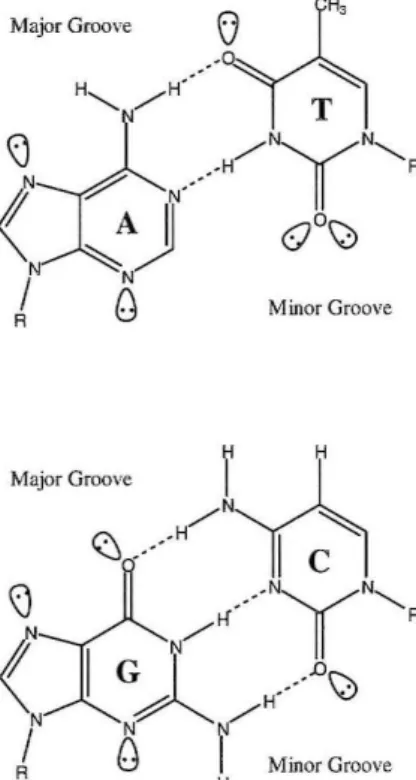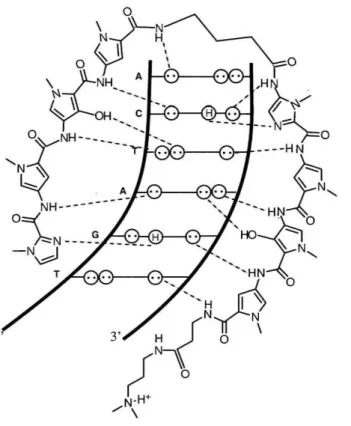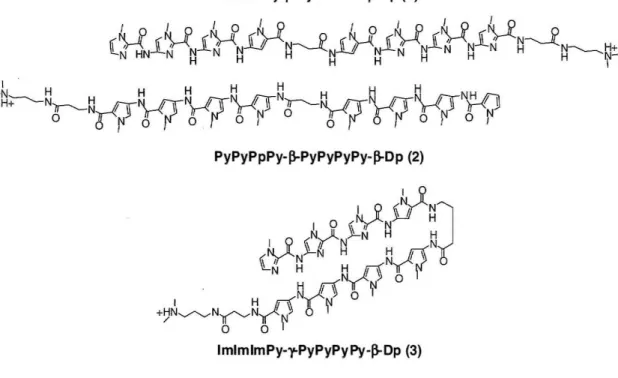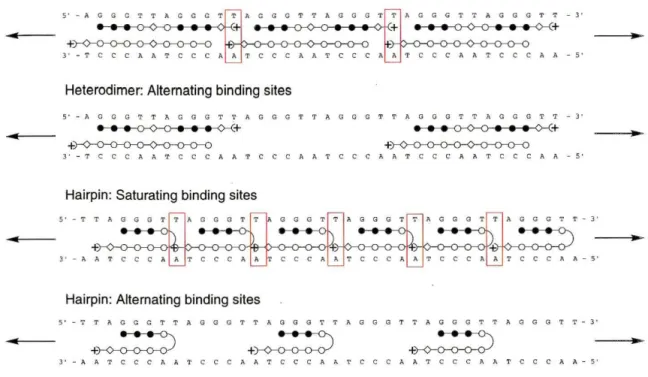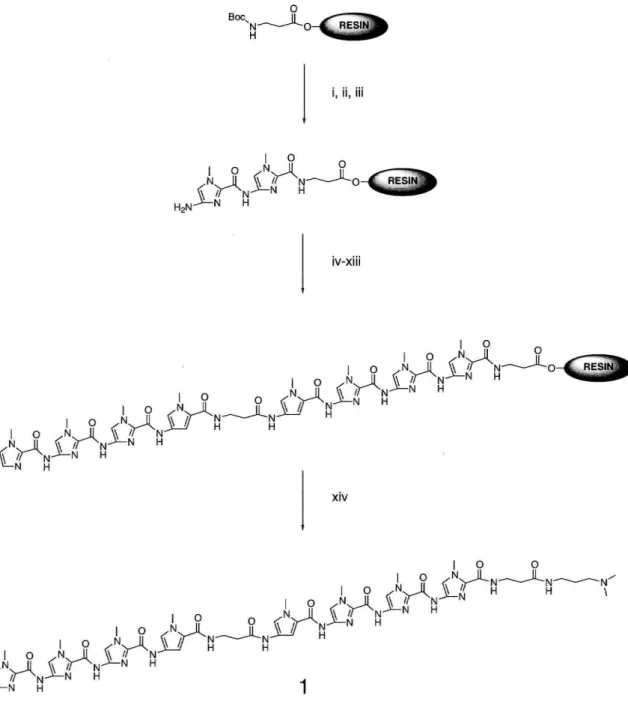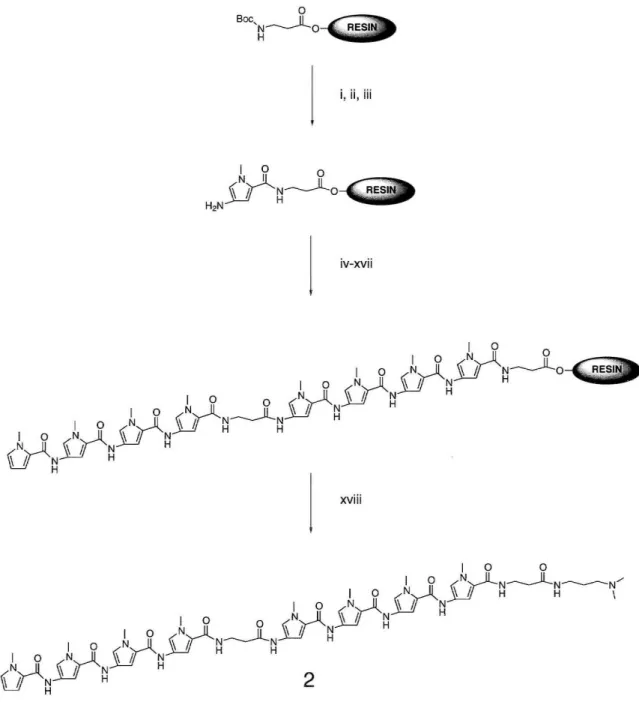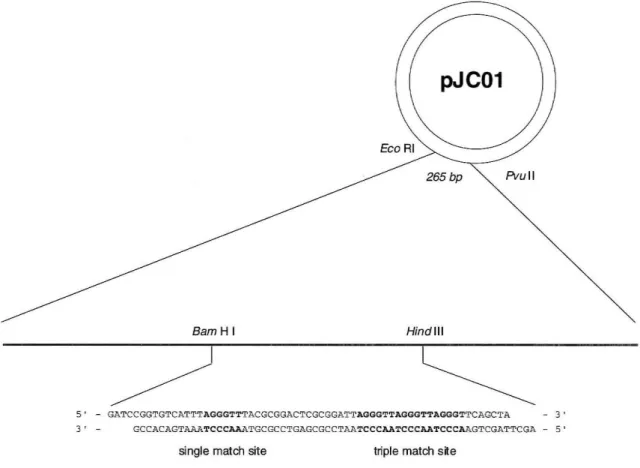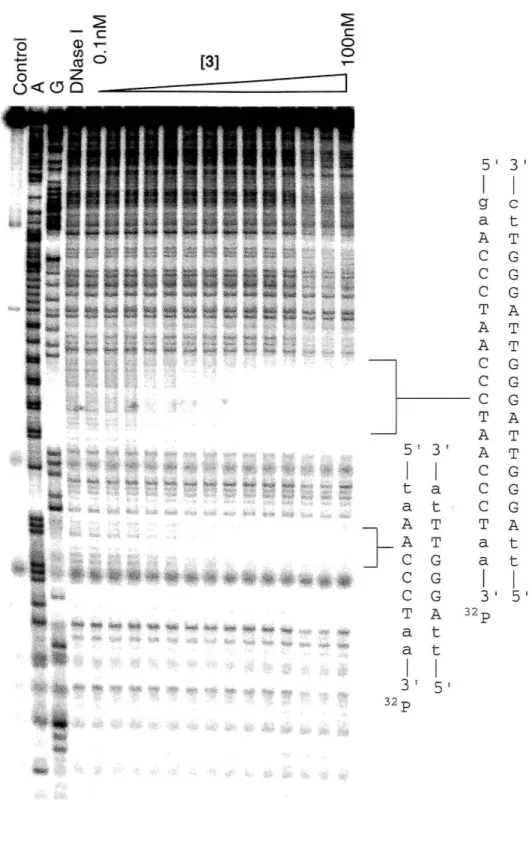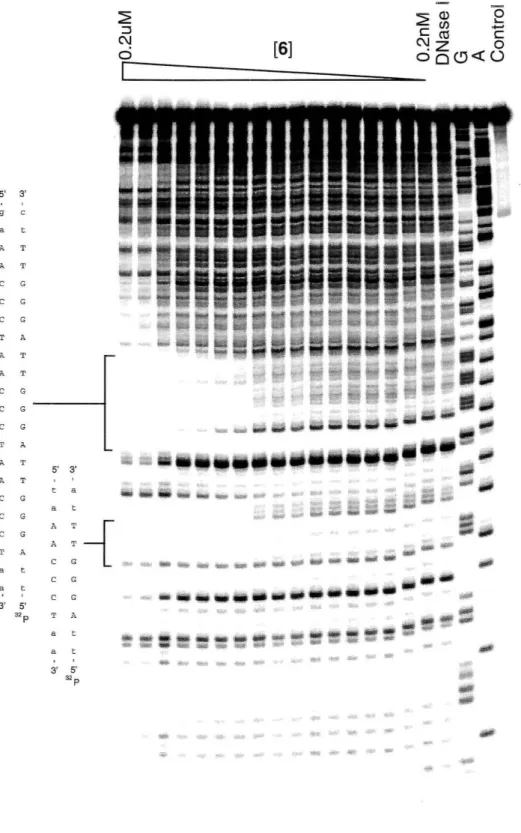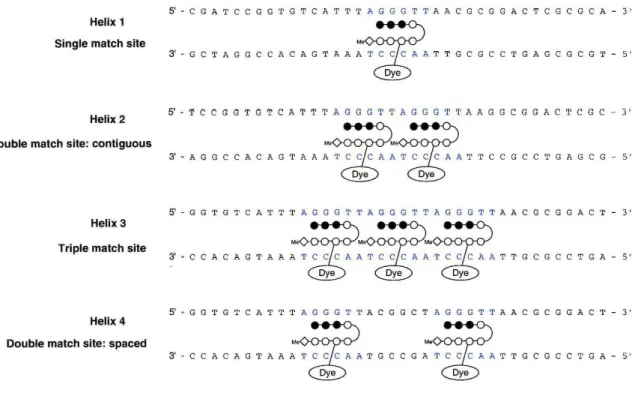Targeting Repeat Sequences with DNA-Binding Small Molecules
Thesis by John Richard Chevillet
In Partial Fulfillment of the Requirements for the Degree of
Master of Science
California Institute of Technology Pasadena, California
2002
Recognition of repeat sequences in DNA would have applications in molecular biology. One ofthe most biologically interesting repeat sequences is the telomeric repeat which composes the ends of eukaryotic chromosomes; in vertebrates 5' -TTAGGG-3'. This sequence has been used as a model to study how DNA-binding polyamide molecules composed of pyrrole (Py) and imidazole (lm) residues bind to repeating sequences. DNase I footprinting shows that the polyamide-fluorophore conjugate IrnImImPy-y-PyPy((CH2)3N,N' ,N' 'trimethylbis (hexamethylene)triamine-
OregonGreen488) PyPy-~-Me can bind the sequence 5'-AGGGTT-3' K. = 1.8x108 M-1•
Quantitative fluorescence titrations with varying patterns of telomeric repeat suggest that the molecule can tolerate another polyamide binding contiguously, but not two.
Truncation of the tail of the conjugate to yield the molecule IrnIrnImPy-y-
Py Py( (CH2)3N ,N' ,N' 'trimethy Ibis (hexamethy lene )triamine-OregonGreen488) Py Py-Me allows the compound to bind three contiguous sites, suggesting that steric polyamide- polyamide interactions control binding in this manner.
Ill.
Abstract
Table of Contents
List of Figures and Tables
I. Introduction
n. Background and Significance
m. Project Aims
Table of Contents
IV. Project Design and Implementation Experimental
References
111.
iv.
v-vi.
1
3 4 5 34 44
Figure 1: Watson-Crick base pairs Figure 2: Polyamide pairing Rules Figure 3: Polyamide design motifs
Figure 4: Ball and stick models of repeat binding Figure 5: Synthesis of Compound 1
Figure 6: Synthesis of Compound 2 Figure 7: Plasmid pJCOl design
Figure 8: DNase footprint of Compound 3 Figure 9: Synthesis of Compound 6 Figure 10: DNase footprint of Compound 6 Figure 11: Fluorescence titration helices Figure 12: Synthesis of Compound 9
Figure 13: Fluorescence spectrum of Compound 6 Figure 14: Fluorescence titration of Compound 6
Figure 15: Linear region of Compound 6 fluorescence titration Figure 16: Synthesis of Compound 13
Figure 17: Binding isotherms for 13 on pICOl
v.
3 6
7 8 9
10 11 14 16 17 19
20 21
21
24 25
Figure 18: DNase footprint of Compound 13 26 Figure 19: MPE footprints of Compounds 6 and 13 27
Figure 20: Fluorescence titration helices with H5 28
Figure 21: Fluorescence image of 96-well plates 29
Figure 22: Fluorescence titration of Compound 6 30
Figure 23: Fluorescence titration of Compound 13 30 Figure 24: Linear region of Compound 6 fluorescence titration 31 Figure 25: Linear region of Compound 13 fluorescence titration 31
Table 1: Least squares regression analysis of Compound 6 titration 22 Table 2: Least squares regression analysis of Compound 6 titration with H5 32 Table 3: Least squares regression analysis of Compound 13 titration 32
vi.
I. Introduction
The biologically most relevant form of DNA is B-DNA, which displays a wide, shallow major groove and a deep, narrow minor groove. 1 Sequence specific recognition of duplex DNA by other molecules is governed by the H-bonding patterns that they can form with the bases. The major groove has conventionally been thought to be a better candidate for specific recognition as it is more accessible and presents a characteristic H- bond pattern for all four Watson-Crick base pairs (Figure 1).2 However, collaborative studies in the Dervan group illustrated it is possible to recognize all four base pairs in the minor groove via a polyamide molecule composed of pyrrole (Py), imidazole (1m), and hydroxypyrrole amino acids (Figure 2).3
H H
Major Groove
I
~/N ~
~ ••••• H
I
C(-I{():"'" N~~~/
/ G
I Minor GrooveR H
Figure 1: Watson-Crick base pairs sbowing major and minor groove H-bonding patterns
DNA binding polyamide molecules have been shown to be cell permeable and have high affinity and specificity for DNA (comparable to DNA binding proteins).4-8 The residues pair side by side in the minor groove; an Im-Py pairing specifies for
G-e,
while a Py-lm pairing is specific fore-G.
A Py-Py pairing is degenerate for A-T and T-A. This degeneracy can be removed by substitution of a hydroxypyrrole residue.3•9 An Hp-Py pairis specific for T~A and a Py-Hp pair specifies A-T. The
2
design of polyamides is limited to five contiguous rings, as an increase in this number of residues does not affect binding affinity and decreases specificity.1O This limitation is overcome by the insertion of a flexible aliphatic linker, ~-alanine. This substitution adds conformational flexibility and ~-~ pairings in the minor groove have been found specify
The ability to sequence specifically recognize DNA by artificial small molecules gives rise to many potential applications in molecular biology and medicine.
Investigation in this area has been ongoing. In collaborative studies, hairpin polyamides have been shown to inhibit RNA Polymerase II transcription.14 In addition, conjugate molecules utilizing a polyamide as a DNA recognition domain, a linker moiety, and a peptide activation domain have been shown to activate transcription in vitro.15
Pyllm
targets e-GHp/Py
targetsT-A Py/Hp
targetsA-T
ImlPy targets G-eFigure 2: Schematic representation of the polyamide ImPyHpPy-y-ImPyHpPy-~-Dp recognizing 5'- TGATCA-3'
II. Project Background and Significance
Recognition and detection of repeat sequences in DNA would have applications in chromosome painting and genomic analysis. One of the most biologically interesting repeat sequences is the telomeric repeat which composes the termini of eukaryotic chromosomes.16 In vertebrates, it follows the hexameric pattern 5'-TTAGGG-3'.17 The bulk of the region is double stranded, however the extreme 3' terminus displays a 12-16 nucleotide single stranded overhang.18,19 The length of the telomere is maintained at
4 approximately 15kb in germline cells, but is variable in somatic cells and decreases with each cell division,18,2o-22 but not necessarily with chronological age in a mechanism referred to as the "mitotic clock, ,m The telomeres shorten until they trigger a p53 dependent check point arrest,24 causing the cell to enter a non-dividing state known as senescence. This state is thought to prevent the ends of the chromosomes from being recognized as double strand breaks, leading to repair by fusion, genomic instability, and apoptosis.25
Senescence has been implicated in aging and its associated pathologies,26-28 Rapidly dividing cancer cells escape this state by activation of telomerase, the enzyme responsible for telomere synthesis (normally inactive in somatic cells) and thus immortalize.29,3o Thus, a probe of telomere length would have significant applications in studies of cancer and aging,3!
III. Project Aims
The goals of this project are:
1. To design and synthesize polyamides that bind repeating DNA sequences,
2. To discern what factors influence their mode of binding.
IV. Project Design and Implementation
The telomeric repeat will serve as the experimental model to study how poly ami des bind repeating sequences. Toward satisfaction of Project Aim 1, two polyamide motifs have been designed to target the telomeric repeat (Figure 3). The first employs the formation of a side-by-side heterodimer couple targeting Ilbp of the repeat:
5'-AGGGTTAGGGT-3'. This will be achieved through the pairing rule complimentary polyamides IrnImIrnPy-~-PyImIrnIm-~-Dp (1) and PyPyPyPy-~-PyPyPyPy-~-Dp (2) (Dp: dimethylaminopropylamine). The second targets the six base-pair sequence 5'-A GGGTT-3' by way of the eight-ring hairpin polyamide ImIrnImPy-y-PyPyPyPy-~-Dp (3) (y: y-aminobutyric acid) that has been previously shown to bind 5'-AGGGAA-3' with a
K.
of 3.7x108M-1 and to have good specificity over mismatch sequences.32Hypothesized modes of binding for these polyamides (PAs) are illustrated in Figure 4. It is proposed that each design will adopt a preferred binding state, either saturating the available binding sites or by binding alternating sites. The mode of binding will be dependent upon polyamide-polyamide interactions and polyamide-DNA interactions.
6
PyPyPpPy-j3-PyPyPyPy-j3-Dp (2)
Figure 3: Heterodimeric polyamide couple ImImImPy-~-PylmImIm-~-Dp, PyPyPyPy-~-PyPyPyPy-~.Dp
and the hairpin ImlmImPy-y-PyPyPyPy-~-Dp
Examples of PA-PA interactions include the potential cation-cation repulsion in the case of the heterodimer (which may be negated by phosphate contacts) as well as tail-tail steric interactions, and the possible steric clash of the y-aminobutyric turn residue of one
hairpin with the Dp tail of the following hairpin. PA-DNA interactions include the distortion of the helix by polyamide binding which may be beneficial or detrimental to a subsequent binding event.
Following synthesis and characterization for DNA binding affinity, experiments are performed on polyamide-fluorophore conjugates to study their mode of binding contiguous match sites by quantitative fluorescence spectroscopy.
Heterodimer: Saturating binding sites
S' - A G G G T T A G G G T - 3'
~+
+~
3' - T e e C A 11 T e e C 11 - 5'
Heterodimer: Altemating binding sites
5' - A G G G T T 11 G G G T T A G G G T T A G G G T T A G G G T T A G G G T T - ).
~+
+~
3' - T e e C A A T e C C 11 A T e C C A A T e C C A A T e C C A A T e C C A A - 5'
Hairpin: Saturating binding sites
S' - T T A G G G T r-;-A G G G T r . r G G G Tr ; r A G G G Tr : r A G G 0 T ~ T • G G G T T - 3'
~ [l 1)- I)r 11
J "
A T C C C • ' -A T C C C A ' -• T C C C A ' -A T C C C A ' -• T C C C A~ T C C C A
3' - A A - 5'
Hairpin: Alternating binding sites
5' - T T A G G G T T ]I. G G G T T A G G G T T A G G G T T A G G G T T 11 G G G T T - 3'
+~ +~ + ~
3' - A A T e C C 11 A T e C C A 11 T e e C A A T e C C A A T e C C A A T e C C A A - 5'
..
..
..
..
Figure 4: Ball and stick models of proposed binding modes for heterodimer and hairpin polyamides.
Filled circles represent pyrroles, hollow circles imidazoles, diamonds ~-alanine, and arcs and plus signs represent dimethylamino-propylamine. Red boxes highlight possibl~ polyamide-polyamide interactions.
Results and Discussion
Monomer and Polyamide Synthesis
Boc-protected Py and 1m amino acids were prepared as described previously. 33 Polyamides were prepared by manual solid-phase stepwise synthesis (Figs. 5 and 6) and purified by reverse-phase HPLC. The heterodimeric pair ImImImPy-~-PylmImlm-~-Dp
and PyPyPyPy-~-PyPyPyPy-~-Dp has not yet been further analyzed. ImlmlmPy-y-
PyPyPyPy-~-Dp was prepared by C. Melander.
BOC,~---..IlO~"IIIo ; .. ;R.E.S.' ...
i, ii, iii
iv-xiii
8
I 0
I O N , J1 0
I 0 £N, J1 £ ir 'N---..IlO~
I O N , J1 ~ ir 'N N H
/N~
fir
'N N HI
o ) J
0 U N - " -N H I O NU
N ---..IlN HI
0
£N, J1frN H H
N, J1 ~ ir 'N-"-N H
( rr
N 'N H N Hxiv
I 0 0
I 0 (NrN---..IlN--- N /'
I 0 (N, J1 J-~ H H \
I O N , JI J-ir 'N
~
f'ir 'N N HI 0 ~I 0 0 ~ /; N-"-N H I O N , JI ~ f, N---..IlN H
I O N , J1 £ir 'N H H
N, JJ
f'
ir 'N N H( f
'~-"-N H 1Figure 5: Sythetic outline for ImlmlmPy~Pylmlmlm~Dp, (i) BO%TFAlDCM/O.5M PhSH; (ii) BoclmlmCOOH, DCC, HOBt, DMF, DIEA; (iii) BO%TFAlDCM/O.5M PhSH; (iv) BocPylmCOOH, DCC, HOBt, DMF, DIEA; (v) BO%TFAlDCM/O.5M PhSH; (vi) Boc-~-Ala, DCC, HOBt, DMF, DIEA; (vii) BO%TFAlDCM/O.5M PhSH; (viii) BocPyOBt, DMF, DIEA; (ix) BO%TFAlDCM/O.5M PhSH; (x) BocimlmCOOH, DCC, HOBt, DMF, DIEA;; (xi) BO%TFAlDCM/O.5M PhSH; (xii) BO%TFAlDCM/O.5M PhSH; (xiii) ImCOOH, DCC, DMF, DIEA; (xiv) dimethylaminopropylamine, 37°C, 1Bhr
iv-xvii
xviii
Figure 6: Sytheti
80%TFAlDCM" c outline for PyP P
80%TFAIDC : (Iv)BocPyOBt, DI:/PYbPYPYPYPYbD " 0
('i)SocP'OB~'6~')BOOPyO",
OlEA N:P, (,)BO%lF,:;6~~"
mWCM, (ii)BooP~~i~OOPyOB;' Ol~, ~:;(t)BO% iF':;'::;'
(Soc"AI.,HB\,:,!,B~~::)BI ,
DIEA, ::'M":;~''(',
NMP, "ii' , NMP, (,,;;;)dim"h,,' .mlO",,,,,'.m,",, ",'
BO%TFMlCM;"::;,,,),m"h"",";""
'~"')SocPyO",
, 12hr DIEA NM NMP, (.) 80% carboxylic acid P, (") BO%lFNDC:TF:;~C
,DCC, HOBt, 'pJC01
BamH I Hind III
5' - GATCCGGTGTCATTTAGGGTTTACGCGGACTCGCGGATTAGGGTTAGGGTTAGGGTTCAGCTA 3' 3' - GCCACAGTa~~TCCCAAATGCGCCTGAGCGCCTAP_TCCCAATCCCAATCCCAAGTCGATTeGA - 5'
single match site triple match s~e
Figure 7: Oligonucleotide insert into pUC19 to create plasmid pJCOl showing single and triple binding sites
Quantitative DNase I Footprintillg Titratiolls
10
To evaluate equilibrium binding affinity for the designed match site and discern the ability of the polyamide to bind match sites in a contiguous repeating sequence (project Aim 1), plasmid pJCOl was constructed containing a single match site for (3) and three contiguous match sites (Figure 7). Quantitative DNase I footprinting titrations were performed according to the method of Trauger and Dervan.34 The hairpin polyamide
~ ~
c c
0 Q) ,.... 0
....
(/)0 [3] 0
... rn ,....
c
o z u<C<DO
5 ' 3' I
g c
a t
A T C G C G C G
-
A T A TA T
} -
C C G G,
C GT A A T 5 ' 3' A T
I
c
Gt a C G
a t C G
}
A A C T T G T a a A t tC G I I
c
G 3 ' 5 ' T A 32p'~ a t
~ ."'ai.:'-' ~
... -
a tI I 3' 5'
32 P
Figure 8: DNaseI footprinting gel of 3 on 3' 32p labeled pJCOl. Control lane represents and intact fragment. A and G represent sequencing lanes for these bases. D represents DNase control lane, no polyamide. Other lanes increase from O.lnM to lOOnM as shown.
12
bound the match site with a
K.
of 7.2x108M·l (Figure 8). A footprint was observed over the whole triple site region. An average quantitative analysis over the triple site yielded aK. =
9.2x108 M·l indicating that the polyamides could bind that area with comparable affmity but unknown mode of binding.Design and Preparation of Fluorescent Conjugate
To maintain binding affinity (as it is usually reduced upon conjugation of a polyamide to another molecule), a rational redesign of the molecule was implemented.
Exchanging the positions of the Dp tail and a pyrrole N-methyl group has been shown to yield a lO-fold increase in binding affinity with no loss of specificity,35 thus the cationic charge was relocated to the third pyrrole residue. The dye chosen was commercially available Oregon Green 488 (Molecular Probes), which has an excitation/emission spectrum almost identical to fluorescein, but higher photostability. The linker design reflects the need for a tertiary amine on the alkyl pyrrole residue, a nucleophile for dye conjugation, and for the finished conjugate to have a net cationic charge, aiding in solubility.
The synthesis of 6 (Figure 9) was accomplished beginning with solid phase preparation utilizing the N-functionalized monomer 3-hydroxypropyl-4-[(tert- butoxycarbonyl)aminoJ-pyrrole-2-carboxylic acid.35 Cleavage from the solid support
resulted in ImImImPy-y-PyPy((CH2)30H)PyPy-p-Me (4). The crude material was extracted, lyophilized, and activated by toluenesulfonyl chloride in pyridine.
Precipitation by ether and nucleophilic displacement by N ,N' ,N"- trimethylbis(hexamethylene)triamine at 37°C gave the free-amine compound (5), purified by HPLC. Reaction in dimethylformamide/diisopropylethylamine with the succinimidyl ester of Oregon Green 488 resulted in 6, subsequently purified by HPLC.
Quantitative DNase I Footprinting Titrations of Fluorescent Conjugate
DNase I footprinting studies were performed with 6 as above (Figure 10). The conjugate bound the match sequence with a
K.
= 1.8x108M·\ averaged over the triple site withK. =
2.2x108M·), and bound the match site proximal to the 5' 32p label within the triple site Ka=
2.2x108M·) (others not reliably quantifiable due to 3' shift in footprint as an artifact of DN ase cleavage). Unlike 3, the footprint of this molecule in the triple match region showed cleavage bands in the center site. This evidence contradicts binding in a saturation mode.Fluorescence Titration Experiment
It was discovered that various designs of polyamide-dye conjugates exhibited fluorescence when in the presence of match DNA, but were quenched over an order of magnitude when alone in solution.36 The fluorescence was found to be dependent on DNA binding as dictated by polyamide pairing rules; fluorescence in the presence of
~
0v~~
I
O,""0N
N J-N H H
~" 1 ~r~
Hy(fN" I I 'N N 1 ~ 0
~N H Hy(f1 N
N 0 I
H g( N
N')('~/ 0 \
~~~g(O~
~~~ ')('~/ ~
o 0 I
MeNH2 , RT, overnight
~
0V~J
I 0 (0N
N Y-N H H
~" 1 ~r~ H-!}N
(71 'N N r 1 0 N
H ~g(O~
H g( ')('~/
H Hy(f1 N')('~I/ 0 ~
/N~N II 0
l
N OH
o 0 I
1) TsCI, pyridine
4
2) N,N'-N"-lrimethylbis(hexamethylene)triamine
Oregon Green 488, succinimidyl ester DMF, DIEA
~
0V~~
I 0
~"0N 6
N_ Jl Y-N H H
~"
1
~r '~H-!}N
f II 'N N r 1 0
"-N H ~ g( 0 ~
H g( ')('~/
H Hy(f1 Nr('( 0 \ I 0
/N~N II N 0
l
N~~N No 0 I I I
o Figure 9: Synthesis of fluorescent conjugate (6)
14
mismatch DNA was correspondingly lower. Investigation is proceeding into the mechanism of this phenomenon.
This discovery presented the opportunity to determine mode of binding by fluorescence increase. A series of DNA helices were designed containing varying degrees and patterns of match sites (Figure 11). Helix 1 (HI) contained a single match site, Helix 2 (H2) a contiguous double, Helix 3 (H3) a contiguous triple, and Helix 4 (H4) two match sites separated by six base pairs that constituted a double mismatch. It was hypothesized that titrating a given helix into a fixed concentration of polyamide conjugate would result in an increase in fluorescence that would indicate mode of binding by rate of fluorescence increase over the titration. Titrating HI into a fixed concentration of polyamide-dye conjugate (PA-dye) was expected to result in a linear increase of fluorescence until the concentration of HI was equal to that of the PA-dye. The PA-dye could then be considered titrated and there would be maximal fluorescence. Beyond this point, no increase in fluorescence should occur. Fluorescence of the P A-dye when titrated with H2 was expected to be dependent on how the P A bound the contiguous double site. If the sites could be saturated (two PAs bound) fluorescence should increase over the titration at double the rate of HI and reach maximal fluorescence when the concentration of DNA is half that of the PA-dye. If the sites are bound by alternation,
16
5' 3'
g
a t
>. T
>. T
C G C G
C G
,
.,A T
A T
C G C G C G
., A
>. T
5' 3'
>. T
C G C G C G T A
A
T
T-{
G
-
c
C G
.-
C G
3' 5'
"p T A
3' 5'
"p
.. ..
- - ... ... ...
Figure 10: DNaseI footprinting gel of 6 on 5' 32p labeled pJC01. Control lane represents and intact fragment., A and G represent sequencing lanes for these bases. D represents DNase control lane, no polyamide. Other lanes increase from 0.2nM to 0.211M as shown.
Helix 1 Single match site
Helix 2 Double match site: contiguous
Helix 3 Triple match site
Helix 4 Double match site: spaced
S - eGA T e e G G T GTe A T T T AG G G T T A A C G eGG ACT C G C G C A - 3'
M'il
3' - GeT A G Gee A C A G T A A ATe C C A A T T G C Gee T GAG C G C G T - 5' Dye
S -Tee G G T GTe A T T TAG G G T TAG G G T T A A G G eGG ACT C G C - 3'
3' • A G Gee A C A G T A A
~ :'~ A
T Tee Gee T GAG C G - 5'' TC £A! TC £A!
5' - G G T GTe A T T T AG G G T TAG G G T TAG G G T T A A C G eGG ACT - 3'
M-;~M'~M'i?
3' - C CAe A G T A A ATe C C A ATe C C A ATe C C A A T T G C Gee T G A - 5'
Dye Dye Dye
5' - G G T GTe A T T T AG G G T T A eGG eT A G G G T T A A C G eGG ACT - 3'
M'i? M'i?
3' - C CAe A G T A A ATe C C A A T Gee GA T C C C A A T T G C Gee T G A - 5'
Dye Dye
Figure 11: Schematic of quantitative fluorescence experiment. Ball and stick polyamides are shown as they would bind by saturation.
the data should resemble that of HI as one polyamide binds the contiguous double site.
In the case of H3, data for saturation should show a fluorescence increase over the
titration at three times the rate of HI and maximal fluorescence when [DNA]
=
1I3[PA-dye]. If the helix is bound by alternation, the data should reflect two polyamides binding.
H4 was designed as a control comparison and to determine if PA-DNA
interactions could effect a PA binding 6bp away (as there should be no PA-PA
interactions). If both sites were occupied, then the data should indicate two PAs binding.
In the case of one P A binding, the data should resemble that from the HI titration.
18
An additional P A was designed utilizing a cysteine linker and fluorescein coupled by maleimide conjugation to imitate the structure of molecules that had shown this effect.
9 was prepared by stepwise solid phase synthesis incorporating a pthalimide protected arnino-pyrrole in place of the previous Py((CH2)30H) residue (Figure 12). Cleavage from the solid support by methyl amine gave the deprotected, methyl tail polyamide 7. Subsequent reaction with Boc-Cys-Trt-OBt in DMFIDIEA and linker deprotection with trifluoroacetic acid and triethylsilane results in the amine/thiol polyamide 8, which was purified by HPLC. Reaction of the thiol with fluorescein 5-maleimide in the presence of sodium bicarbonate and an reducing agent yielded 9, purified by HPLC. However, this molecule displayed poor solubility and thus was not further characterized for its DNA binding or fluorescent properties.
~
0~~ J
I 0
(0N
N ...L-N H
H I
Jl i0~ yffN
( Nil 'N N ~ r I O
~
N H Hyff1 N
N 0 IH
n
NNf('~/ 0 \
~~~no~ ~n
...
f('r;.s/ NPtho 0 I
~
0~~J
I 0 ~0N
N Jl)'-N H H 7
~
Jl
iir'~HyffN
( II 'N N r 1 0
N H ~
n
0 ~H
n
f('~/H Hy(fl Ny'V
I '0 \
/N~N 0
II N NH2
o 0 I
1 )BOCCysTrt, DCC, HOBt 2) TFA I Et3SiH
~
0if~~
I 0
(0N
N ...LN H H
~. Jl ir~ Hy(fN
( II ~
N H HyQI N
'N N N 0 r I o IH
n
NH H nNf('( 0 \
/N~Nf('~/ 0 NH
o 0 I ~
o : SH
NH2
Fluorescein-maleimide, NaHC03, H20, DMSO
~
0~~J
I 0
(0N
N )'-N H H
I Jl i0~ y(fN
(Nil 'N N ~ r I o
~
N H HyQl N
N 0 IH
n
NNf('~/ 0 \
~ ~
n
0 ~ 0"~f('~/ NH ~
o 0 I ~ N
o . S I
NH:;+ 0
Figure 12: Synthesis of fluorescent conjugate 9
8
9
o OH
5000
""\
~?
4500
4000
~3500
~
-S3000
~
1 \
\
'a 2500
~
.!!
2000
1500
\
1000
500
a
500
\
~,,
510
Fluorescence Emission Spectrum
.Ao ....
"'~
.
"" , 1:1 polyamide-DNA
,,/ ..
.~ ,~
29,6xitlCraase
,,- ,
~,
"-
.. ...
'
...
. ~
:~
V
pOlyamlQe a'ione520 530 540 550 560
'W aye length (nm)
Figure 13: Fluorescence spectrum of compound 6 alone in aqueous solution and in the presence of equimolar match DNA
20
The previous conjugate (6) exhibited a 29.6-fold increase in fluorescence in the 1:1 molar presence of single match site DNA as compared to free in solution (Figure 14) and it was selected for use in the titration experiment.
A 96-well plate assay was developed where the concentration of polyamide conjugate was held constant and titrated against increasing concentration of helix. Buffer conditions and equilibration times were identical to footprinting experiments. The transparent plates were analyzed for fluorescence by scanning on an imaging
• .
E'.:I
,
'.:I
•
•'.:I e ....
'.:I
Normalized Change in Fluorescence .s. [DNA]/[PA]
1.2
1.1 '"
. .. • • " . ., .
•• .
D .•
0 .•
,,~ I! .+
• ~ ;'
.
"r'y ~
+. ..
'",,, ,,.~ •
•
+0.7 0 .•
• .
~ --.
0.5
,. •
•
OA ..."...
0.3
...
0.2 +
0.1 .1'
0
•
o 0.1 0.2 0.3 0.4 0.5 0.6 0.7 O.B 0.9 1 1.1 1.2 1.3 1.4 1.5 1.6 1.7 1.8 1.9 2 2.1 2.2 2.3 2.4 (ONA)JIPA]
0.9
0.8
0.7
0 .•
0.5
OA
0.3
0.2
0.1
o
Figure 14: Quantitative fluorescence titration for compound 6
linear Region. of fluorescence Titration.
I " ....
. /I i
+,,/ / /•
,
,/
/+ ",-, , "f'!
,~/ ,~
: ...
/
..
./"-/(I / /
} . .
// /
I
,,/' .j
"' .
I
• Helix 1
• Helix 2 Helix 3"
X Helix 4 - Linear (Helix 1) - linear (Helix 2) LiMar (Helix 3) - linear (Helix 4)
/ ".,+
V
yr '" .o 0.1 0.2 0.3 0.4 0.5 0 .• 0.7 0.8 0.9
(DNA Heolix]l[PA]
Figure 15: Linear regions of quantitative fluorescence titrations on compound 6.
22
Helix polyamide/helix [Helix]/[PA] at max. fluorescence (extrapolated from linear trend)
1 1.02 0.98
2 2.11 0.460
3 2.25 0.436
4 2.17 0.456
Table 1: Least squares regression analysis of quantitative fluorescence titration. Reported numbers are the average of two experiments.
system, and the individual well images quantified for fluorescent intensity. The results of the experiments are shown in Figures 14 and 15.values listed in Table 1. The data for HI supports the predicted 1 PA:1 Helix binding mode for this duplex. Polyamide/helix
=
l.02, very close to the expected value of 1.00. Extrapolation of the trend to maximal fluorescence increase yields a value of 0.98 DNAlPA, also very close to the predicted value of l.00.
H2 yielded results comparable to H3 and H4. Polyamidelhelix for H2-H4 were 2.11, 2.25, and 2.17 respectively, and extrapolation of the linear portion of the data shows DNAIPA values of 0.460, 0.436, and 0.456, each approximating the expected result of 0.500 for two polyamides binding per helix. This result requires re-evaluation of the
mode of binding by alternation, as the H2 data should have more closely resembled the HI data and not H3 and H4 if this were the case.
Instead the data suggest that it is possible to bind two contiguous polyamides if no other match sites are available, but alternation is preferred when more sites are available.
It is hypothesized that this is the result of the ability of the conjugate to tolerate one proximal polyamide binding (as in the case of H2) but not two (as in the case of H3).
Conclusions
The methyl tail polyamide 6 binds the match sequence 5'-AGGGTT-3' with
K" =
1.8x108M-1• The manner that it binds contiguous repeats of this sequence is dependent on their presentation. Two contiguous match sites are bound by two polyamides, saturating the available sites. Three contiguous match sites are bound by two polyamides occupying either contiguous or alternating sites.
Conjugate Re-design
As 6 was not able to saturate the triple binding site, molecular design was
reconsidered. It was hypothesized that omission of the ~-alanine residue in the polyamide tail would relieve steric interference between two polyamides attempting to bind in a contiguous manner. Polyamide 10 (Fig. 16) was synthesized in a stepwise manner using reaction conditions suitable to the oxime resin support.3S Upon cleavage with neat methyl
Figure 16: Synthesis of truncated tail conjugate 13
10
11
1) TsCI, pyridine, OOC
2) N-N'-N"-trimethylbis(hexamethylene)triamine, DMF,37"C
Oregon Green-SE, DIEA, DMF
24
Single Sit" First in Tripi" Sit" Tripie Sit" Av"ril~
Figure 17: DNA binding isotherms for polyamide conjugate 13 on pJC01
amine, the C-tenninal methyl-amide molecule 11 was obtained. Conjugation was then performed as before, yielding 13.
Quantitative DNase I Footprillting Titrations of Fluorescent Conjugate 13
DNase I footprinting was performed with 13 as before. (Fig. IS). The conjugate bound the match sequence with Ka = S.7xl07M-\ the first site in the triple match with Ka
=
1.2x108M-1 and averaged over the triple match site with Ka=
l.lx108M-1• MPE Footprinting of Fluorescent Conjugate 13To obtain a highly resolved footprint of both conjugates, MPE studies were performed with 4nM-4~M conjugate equilibrium concentrations (Fig. 19). The short-tail conjugate showed a footprint over the entire triple site region at the highest concentration performed, the same concentration at which it gave a total footprint over the single site. The p-alanine containing conjugate was unable to completely protect the triple site at
4~M, although it was able to footprint over the single site at lower concentrations. This
26
::. c:
'"
o [13]
3' 5'
9
•
: ~ A
G C
G C " .
G C
a Me t
) i}--{
: ~ :
G C
3' S'
G C".
G C
a
a Met
: n; ~ ~
~ G C
5' 3' G C " .
"p
G C
- ...
I
a Met
5' 3'
"p
Figure 18: DNase I footprinting of 13 on 5' labeled pJCOI
3' 5' g a
T ijs '
T A
G C
G C ~
G C
a Me t
T ~ ijs ' ~- --{
a Me t
T
T G Gffi
C C A ~G C
5'
"'p
~e t a
3'
3' 5'
a t
: ffi ~ -{
T A
G C
G C ~
G C
I Met
a a
5' 3'
" p
Figure 19: Autoradiogram of MPE footprinting gel for 6 and 13 on 5' labeled pJC01
Helix 1 Single match site
Helix 2 Double match site: contiguous
Helix 3 Triple match site
Helix 4 Double match sHe: spaced
5'· eGA Tee G G T G 'I" CAT T T AG G G T T A A C G e GG:'. C -T C G C G C A - 3'
3' • GeT ,. G Gee ,. C A G T A A
~A
~T~Aj ' T G C Gee T GAG C G C G T • 5' 5'· Te e G G T GTe A 'I' '1' TAG G G T TAG G G T T A A G G eGG ACT C G C - 3'3'· A G Gee A C A G T A A
:~2
TC£A.;'I"Ci£~} T Tee Gee T GAG C G - 5'5'· G G T GTe A T T TA G G G T TAG G G T T;'. G G G T -1' A A C G eGG AC T - 3'
3' • C C A e A G , A , • •
2~~ ,. T CifbA;' . T Cifb;'· A T (jjI)""]'
T T G C Gee T G A - 5'5' • G G T GTe :.. T T T ;.. G G G T T A e GG C T;'. G G G T T A 1-. C G eGG ACT - 3'
3'· C CAe A G T A ,.
2
~T CifbA ; .
T Gee G2
~T Cit"
~ T T G C Gee T G A - 5'28
Helix 5 Triple match sHe: spaced
5' - G G T GTe A T T T " G G G T T A eGG e T A G G G T T A eGG e TA G G G T T A. A C G eGG AC T - 3'
3' - C CAe A G T A A
~A
;T~Al T Gee G~A
1,.T~Ai T GeeG~.
"T~Ai T T G C Gee T G A - 5'Figure 20: Helices for new series of titrations including spaced triple match H5.
evidence supports the saturation mode of binding for the short-tail compound (13) and contradicts it for the long tail compound (6).
Fluorescence Titration Experiment with Both Conjugates
The fluorescent titration of both compounds was performed as before with the addition of a new helix (Fig. 20). U5 contained three binding sites separated by six base- pairs each. This design should completely remove steric effects between polyarnides binding 3: I with the helix and would allow for the observation of the fluorescence increase of this event. The results of these titrations are shown in Figs. 21-23.
[Helix](IlM)
5 2.5 1.5 1 0.88 0.75 0.65 0.5 0.4 0.3 0.2 0.1 H1 • • • • • • • • • •
H2
eeeeeeeee e e
H 3 . , • • • • • • • • • • •
H4 • • • • • • • • • • • HS • • • , • • • • • • • • •
Compound 6 (1 j..LM)
[Helix](j..LM)
5 2.5 1.5 1 0.88 0.75 0.65 0.5 0.4 0.3 0.2 0.1 H1 • • ' • • • • • • •
H2 • • • , • • • • • • • • H3 • • , • • • • • • • • • • H4 • • • • • • • • • • • HS • • • • • • • • • • • •
Compound 13 (1 j..LM)
Figure 21: Fluorescence intensity image of 96-well plate titrations
Conjugate 6 yielded results similar to the first series of titrations for Hl-4. A least squares regression analysis of the linear portion of the normalized data resulted in the values for polyamide per helix in Table 2. HS showed a value of 2.74 polyamides per helix, approximating the theoretical value of 3.00.
The titration data for 13 did not maintain linearity as far as the data for 6. This may be explained by the lower Ka for 13 and may account for the lower than anticipated
1.2
x
· 'lK
x
•
•
lK
•
I"
*
0.2
•
o
O.OOE+OO
• •
• •
1.2
t 0.8
1 =
~_O.6.!
..
JI:
x ;t:.c x i"
JI: 1i •
,"""
. ..
• •
•
*
*
1.00HOO
Normalized Titration Results for Compound 6
x !i
!
2.00E+OO 3.00£+00 [DNA)/[PAI
4.00£+00
/I<
5.00£+00 6.00£+00
Figure 22: Quantitative fluorescence titration for compound 6
Normalized Titration Results for Compound 13
•
JI:~
i
lKX X
JI:
•
..x
x . X
• *
•
X.
)(••
• . ' .
i
~O.4..
z •
.. •
x _
..
0.2
- . -
•
o
0.00£+00 5.00E-01 1.00£+00 1.50E+00 2.00£+00 2.50E+00 3.00E+00 3.50E+00 4.00£+00 4.50£+00 5.00E+OO [DNAIIIPA)
Figure 23: Quantitative fluorescence titration for compound 13
30
linear Region of Compound 6 Titration
0.9~---,
o 0.05 0.1 0.15 0.2 0.25 0.3
(DIIA)I(PA)
Figure 24: Linear region of quantitative fluorescence titration for compound 6
linear Region of Compound 13 Titration
0.35
0.6~---~---__ --,
o 0.02 0.04 0.06 0.08 0.1 0.12 0.14 0.16 0.18
(DIIA)I(PA)
Figure 25: Linear region of quantitative fluorescence titration for compound 13
0.2
• HI
• H2 H3 X H4
'" H5
- linear (HI) - Linear (H2) - linear (H4) linear (H3) - linear (H5)
• HI
• H2 H3 )( H4
'" H5
- Linear (HI) - linear (H2) Linear (H3) - Linear (HS) - Linear (H4)
32
Helix [Helix]/[PA] at maximum polyamides per helix
fluorescence
1 0.990 l.01
2 0.565 l.82
3 0.435 2.35
4 0.510 l.96
5 0.379 2.74
Table 2: Least squares regression analysis of quantitative fluorescence titration on compound 6.
Numbers are the average of three experiments.
Helix [Helix]/[PA] at maximum polyamides per helix
fluorescence
1 1.39 0.76
2 0.641 l.65
3 0.352 2.84
4 0.704 1.53
5 0.410 2.52
Table 3: Least squares regression analysis of quantitative fluorescence titration on compound 13.
N umbers are the average of three experiments.
polyamide per helix values. HI yielded a polyamide/helix value of 0.76, approximating the theoretical value of l.00. H2 and H4 yielded comparable results to each other, 1.65 and l.53 respectively, approximating the theoretical value of 2.00. H3 and HS showed
values of 2.84 and 2.52 respectively, approximating the theoretical value of 3.00. The observation that H2 and 04 follow similar trends and that H3 and H5 follow similar trends provides evidence that 13 can bind the repeat sequence contiguously.
Conclusions
The ~-methyl tail compound (6) binds the match sequence 5'-AGGGTT-3' with Ka
=
1.8x108M-1• The truncated methyl tail compound (13) binds the match site 5'- GGGTT-3' with Ka =- 8.7x107M-1• MPE footprinting illustrates that 6 is unable to bind contiguously three adjacent match sites at the highest concentration tested, but the short- tail conjugate 13 protects all three sites from cleavage. Fluorescence titration data compliment this result and evidence that 13 can bind three 5'-TTAGGG-3' sites contiguously.Discussion
The data suggest that in the model case of 5'-(TTAGGGk3', a steric clash or other localized polyamide-polyamide interaction occurs when the sequence is targeted using a ~-methyl tail eight ring hairpin polyamide. This prevents the molecule from consistently binding the three contiguous sites, as evidenced by MPE footprinting and fluorescence titrations. Omission of the ~-alanine residue to form 13 appears to relieve this steric clash, allowing for contiguous binding.
34
Experimental
Materials
Boc-protected monomers were prepared as described previously.33 Dicyclohexylcarbodiimide (DCC), Hydroxybenzo-triazole (HOBt) and were purchased from Peptides International. N,N-diisopropylethylamine (DIEA), N,N- dimethylformamide (DMF), dimethylaminopropylamine, N,N' ,N" - trimethylbis(hexamethylene)triamine, pyridine, dimethylsulfoxide (DMSO), triethylsilane, and toluenesulfonyl
